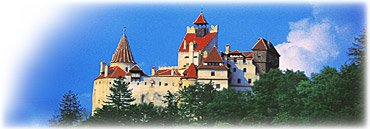|
||||||
|
Fast Facts
Official Name: Romania
Location: Central Europe (southeastern part)
|
|
|
Time Zone: Seven hours ahead of U.S. Eastern Standard Time (GMT + 2)
Area: 91,725 sq. miles (237,502 sq. km)
Population: 21,700,000 (2002) 22,500,000 (2005 - forecast)
Ethnic Groups: Romanian 89%, Hungarian 7.5%, Gipsy 1.9%, German, Other 1.6%
Religions: Christian Orthodox 87%, Roman Catholic 5%, Protestant 5%, Jewish
Official Language: Romanian German and Hungarian are spoken in some counties
Climate: Temperate, four distinct seasons: pleasant temperatures during Spring and Fall, hot Summers, cold Winters
Capital: Bucharest (Bucuresti)
Form of Government: Republic with two legislative bodies: Senate and Chamber of Deputies
Romania is situated in the southeastern part of Central Europe and shares borders with Hungary to the northwest, Yugoslavia to the southwest, Bulgaria to the south, the Black Sea and Ukraine to the southeast and to the north and the Republic of Moldova to the east. Roughly the size of Oregon, Romania is the second largest country in the area, after Poland. Geographical location of Romania: between latitudes 43°37'07" and 48°15'06" North and longitudes 20°15'44" and 29°41'24" East.
Romania extends approximately 300 miles North to South and 400 miles East to West.
Bucharest — the capital city of Romania — is aligned approximately with the cities of Portland, Oregon; Montreal, Canada; Venice, Italy; and Bordeaux, France.
Romania's territory features splendid mountains, beautiful rolling hills, fertile plains and numerous rivers and lakes. The Carpathian Mountains traverse the center of the country bordered on both sides by foothills and finally the great plains of the outer rim. Forests cover over one quarter of the country and the fauna is one of the richest in Europe including bears, deer, lynx, chamois and wolves. The legendary Danube River ends its eight-country journey through eight European countries at the Black Sea by forming one of the biggest and most interesting wetlands in the world, the Danube Delta.
About a third of the country consists of the Carpathian Mountains (also known as the Transylvanian Alps). Another third is hills and plateaus, rich with orchards and vineyards. The final third is a fertile plain, largely devoted to agriculture. The Danube River runs through the country, from northwest to southeast, culminating in the Danube Delta and the Black Sea.
Physical features • Mountains: 31% of Romania's territory • Hills and orchards: 36% • Plains: 33% • Areas covered by rivers and lakes: 3.7 % • Total number of lakes: 3,500 • Lakes greater than 250 acres: 300 • Highest mountain peak: Moldoveanu Mt. — 8,349 ft. (2544 m.) |
|

